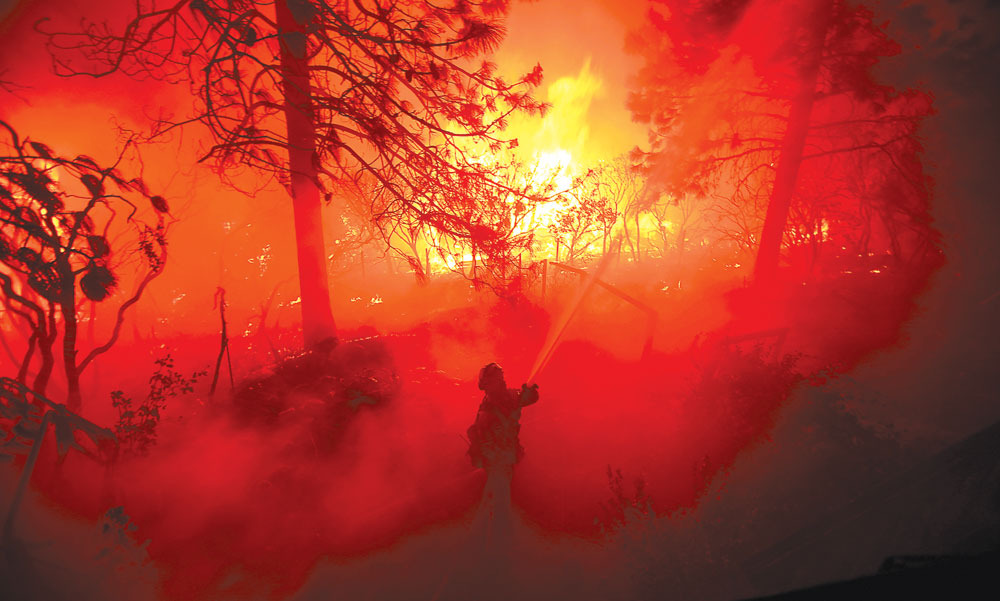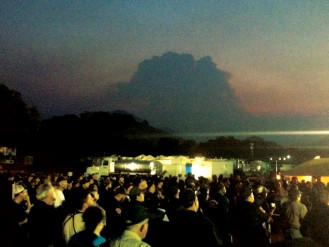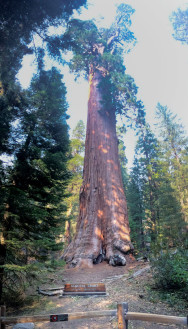
A firefighter sprays water as a fire rages on Cobb Mountain north of Santa Rosa, Calif. Because of the growing number of fires near communities, U.S. Fish & Wildlife Service employees from all over the U.S. are called in to help with the complex fire management process. Photo by Kent Porter / The Santa Rosa Press Democrat.

The fire management crew convenes for the daily 6am briefing, as a cloud of smoke builds in the background.
Dave Lucas was at the dentist for a 3pm appointment when his phone rang. The dentist finished her work and Lucas rushed home, where he tossed his gear in the car, ate a quick meal with his family, said goodbye, and drove north to Idaho.
William Kutosky was at work preparing field maps for the restoration crew when his phone rang at 1:30pm. He grabbed his bag that had been packed for a week, and in less than two hours was on the road to Montana.
Nick Kaczor was in his office preparing an exhibit for the black-footed ferret when his phone rang at 12pm to report he had a 3:30pm flight. After landing he drove a few hours into the Idaho night; the sun had set hours before but the hills glowed red and orange. He could barely see a quarter-mile ahead from the smoke.
All three are U.S. Fish & Wildlife Service employees who work at the Rocky Mountain Arsenal Wildlife Refuge in northeast Denver and are called to help manage wildfires every summer.
Some may think of fire as a bad thing, but it is necessary for habitats, and many species rely heavily on fires to germinate their seeds, according to the Fish & Wildlife Service. The fire crews do not want to put out fires, but manage where they burn. Fire becomes a problem when it threatens people’s safety, like the California fires that have charred 800 homes. Fire crews are able to move fires around urban areas and archaeological sites. Lucas worked a shift in California this summer where the fire management crew preserved Grant Grove, home of the General Grant sequoia—once thought the largest, but later determined to be the second-largest sequoia. Firefighters moved the fire down the west side of Highway 180 north of the area, and then west around the giant sequoia grove. “That burned area will not burn again, thus creating a containment line,” he says.
Fish & Wildlife Service employees are fire-trained and typically have experience with prescribed fires, or controlled burns, on refuge land. Each employee is assigned a division within fire management. “The person who designed it must have worked in the military because everything has a process and each person has their specific, important role,” says Lucas, refuge manager. Lucas worked in the financial division to allocate resources; Kaczor worked in the planning division to compile a 60-page report of daily tasks; and Kutosky worked directly with the fires as a squad boss to help manage the engines, or vehicles that pump water on the fire line. They typically work 16-hour days with a chance for a brief break around lunch. At about midnight or 1am, they go to sleep in tents or under the stars.
“We can all mobilize quickly and come together and know our role,” says Nick Kaczor, assistant refuge manager. At the refuge, he promotes habitat restoration, helps with the biology program, operates the tractor, and assists with exhibits in the visitor center, which next month will feature the black-footed ferret—the most endangered mammal in the U.S. that is being reintroduced at the refuge. “You get people from the Fish & Wildlife Service, Park Service, the Department of Fire Prevention, Boulder County or Jefferson County, and then contractors who have this as their gig, and everybody knows their role. You have to stay in your box.”

Fire crews protect historic and archaeological sites, like the General Grant sequoia, the second largest sequoia at 268.1 feet tall and 107.5 feet around. The tree’s age is unknown but estimated to be somewhere between 1,800 and 2,700 years old, according to the Sequoia National Park Service. Fire crews saved the tree by moving the fire west along Highway 180.
Kaczor admits he felt a little nervous driving into the smoky Idaho night, but knows if a firefighter maintains good situational awareness, serious injury is unlikely. William Kutosky has seen flame lengths taller than 100 feet, but never felt nervous for his safety. The crews strategically plan their approach considering weather, humidity and terrain, and are never near a fire when they suspect it may “blow up,” or suddenly accelerate or intensify. A blow-up can turn into a firestorm, a tornado-like whirl of flames. Employees typically only have minor complications, like bee stings or dehydration.
“It’s incredible work,” says Kutosky, biological science technician at the refuge who focuses on habitat restoration. “First of all, I get to meet a lot of new people, there are travel opportunities, and I get to spend a good portion of my day outside working to improve wildlife habitat.”
Because of the growing number of communities, fires are more complex to manage and require many personnel, according to the U.S. Fish & Wildlife Service. In 1978, the Service established a formal fire program with professional standards and paid regional fire managers. The program is based out of the National Interagency Fire Center in Boise, Idaho, and staffed by 500 permanent employees, 200 seasonal workers, and more than 2,000 Service employees like Lucas, Kutosky and Kaczor who assist on a “call-when-needed” basis.
The fire center gives Service employees a preparedness level so they have an idea of when they may be called and can be ready at a moment’s notice. Employees can be assigned anywhere in the U.S. for any amount of time, and may have a consecutive shift in another part of the country. They typically have one day to report to their assignment.
Lucas, Kutosky and Kaczor have completed their wildfire management for this summer, and look forward to next year’s. Although it is difficult to be away from family, the annual event—much like the military—provides a sense of adrenaline, purpose and camaraderie.



0 Comments